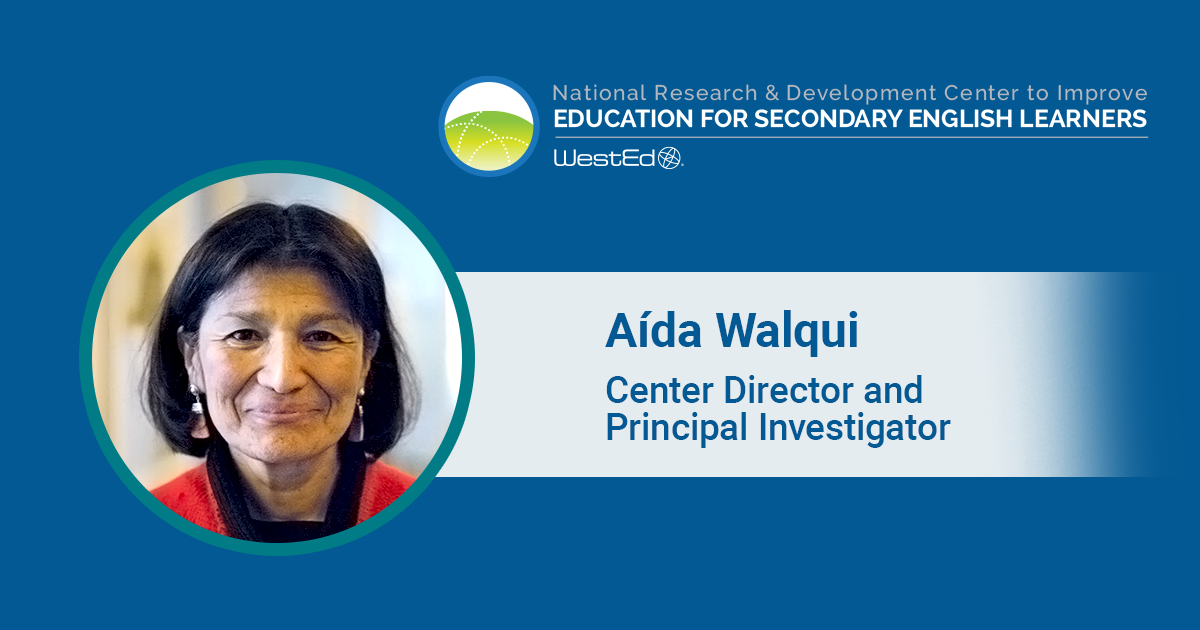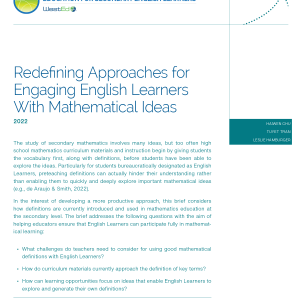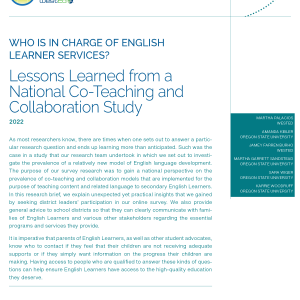Quality Interactions Are Crucial, Especially for Those Learning English
Posted on

Written by Aída Walqui, Director of the IES-funded National Research & Development Center to Improve Education for Secondary English Learners
Perhaps never in human history has understanding and collaboration with others to problem-solve been so needed. From climate change to international conflict, to spiraling deficits to global poverty, to racial strife—solving intractable dilemmas requires breakthrough thinking, action, and trust among people.
Progress requires one key thing—not only of adults but also of the K–12 schools we rely on to prepare future generations of students for modern challenges.
Communicating—a social act.
Interestingly, K–12 teaching and learning models in the United States are not necessarily designed to effectively socialize students or teach them to interact. Take the experience of English Learners, especially salient given that new census data project that one in four Americans will be Latino by 2060.
When students who possess varying levels of English proficiency—or none—enter American school buildings, they are required to learn English and learn in English. But often, if you walk into an English Language Development classroom, you will find only a handful of students, if any, speaking. In fact, students in such classrooms are rarely “invited” to speak freely and are more often admonished for their “incorrect” grammar or vocabulary.
To make matters worse, English Learners are typically held back from other core subjects until they learn English, which they may not have a fair chance to “master” in the first place.
So why would “communicating socially” enable students at different starting points to leap forward? How would it make possible the simultaneous learning of academic content and critical thinking skills? How can students communicate in English when they don’t yet know it well?
In an effort to uncover answers, researchers at the IES-funded National Research & Development Center to Improve Education for Secondary English Learners are currently studying how to advance English Learners and all students more quickly and deeply.
Here is what we’ve learned.
Models of teaching and learning drawn from learnings in sociocultural and sociolinguistic research to engage students in what are called “Quality Interactions,” enlist three inborn student drives.
First, the drive to belong to social groups.
Second, the drive to find meaning behind language.
Third, the drive to consistently understand why we are doing what we are doing.
Here is how they work. Simultaneous with academic activity, Quality Interaction classrooms we have witnessed develop a joint culture and climate of mutual respect among students and teacher, working to understand each other, contribute, and build deeper shared knowledge and dispositions. This new social fabric helps motivate students to learn.
Participation, although naturally slow at first, grows as students are invited into group interactions. Teachers introduce carefully chosen course-specific topics and texts designed to be personally relevant to those in the room, and groups practice thinking out loud with each other using whatever English they have developed so far.
Through this approach, teachers build trust and conceptual, analytic, and language practices.
As the lesson continues, differentiated, dynamic prompts allow students to choose how to interact. Students become more comfortable, increasingly engaged, and motivated to absorb words and ideas.
Although they “spark” at different times, each child has the ubiquitous ability, through “quality” dialoguing, to derive lasting meaning naturally and personally behind words by using them across contexts and acting on their understanding. Learners care about language because it matters to them … socially. They are accountable to numerous peer teachers.
Recall what you remember from school. Chances are that your brain will have cataloged the rare moments in which you “got” powerful concepts. More often than not, those instances emerged during social exchanges. This is why sports, theater, and project-based learning are such powerful experiences.
The more enticing and comfortable the social entry points, with teachers modeling what peer encouragement looks like, the more opportunities for students to make learning connections, think critically, and derive meaning—all within a safe web of support.
While previous research shows that Quality Interaction benefits all students, the model is particularly important for English Learners, who need every opportunity to practice speaking. And as the world increasingly values multilingual, intercultural, diverse perspectives, this is more and more students.
In a Quality Interaction math classroom, for example, the message is ever present: Every student is valued for the knowledge they bring in—and every student is a critical thinker with expertise that can expand over time. Yes, every student—even students who barely or imperfectly speak English.
Across subjects and grades, there is little conceptual academic growth that does not entail language development. Conversely, there is little language learning that does not include conceptual and analytical skills development. Math and language, science and language, social studies—as compared to language—are not different subjects.
Language is the necessary means toward the end of developing these core content skills and abilities.
Language develops thinking. Socialization—through carefully constructed interactions around core ideas—brings humans together to move forward and progress in schools and society. When trust is established between humans, learners become more comfortable taking risks at developmentally appropriate times, and children feel they belong and connect. Learners venture out into their Zone of Proximal Development, the area beyond what they can do independently, to accomplish new actions with the assistance of others with whom they co-construct knowledge.
With high challenge and high support from their teacher—who can provide this to all students once the heavy burden of “leading the lesson” is lifted—students go for depth and build on existing understanding. “Aha moments” increasingly spark. Multiple clues and perspectives produce infinite opportunities to construct understanding—to get closer and closer to the conceptual essence of a lesson.
Toward a realization their brain will remember far down the road.
It is precisely the degree to which students are improving in math and English language arts under such models that our researchers are currently studying across the country. We invite you to follow our center as we release findings and insights over the next two years.
While previous research shows that Quality Interaction benefits all students, the model is particularly important for English Learners, who need every opportunity to practice speaking.
And as the world increasingly values multilingual, intercultural, diverse perspectives, this is more and more students.
Best of all, the model may instill a profound respect for the power of collaborative problem-solving.
Future generations prepared to participate in communities that solve issues and persevere.
Imagine that.
The Institute of Education Sciences (IES), U.S. Department of Education, supports this research through Grant R305C200008 to WestEd. The opinions expressed are those of the authors and do not represent the views of the Institute or the U.S. Department of Education. IES is the statistics, research, and evaluation arm of the U.S. Department of Education. IES is an independent and nonpartisan organization created by the Education Sciences Reform Act (ESRA) of 2002, and it is the leading source of rigorous education research and evaluation. It consists of the National Center for Education Research (NCER), the National Center for Education Statistics (NCES), the National Center for Education Evaluation and Regional Assistance (NCEE), and the National Center for Special Education Research (NCSER).


